Visiting Aravind
After years of hearing about the incredible Aravind Eye Hospitals, I finally was able to visit this prototypical social enterprise. Their model is to charge 30-40% of their patients enough to pay for their costs as well as the rest of the patients, as well as something extra (which generates funds for capital expansion).
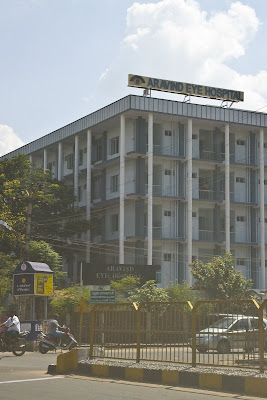
I visited the main hospital in Madurai, where Aravind was founded by the late Dr. Venkataswamy ("Dr. V"). This was Dr V's retirement project! He came back from a visit to the United States impressed with McDonald's as a service delivery system, and decided to bring that same systematic approach to eye care. I've met with Thulsi, the executive director, in Europe at different events, but this was my first time on his (impressive) home turf.

Aravind's mission is to eliminate needless blindness, and they approach this objective with an amazing level of rigor. They are data-driven in a way that it is transparent to patients and staff alike. Every facility I saw had boards noting the daily activity. Target plans were readily accessible: I was visiting during school holidays and they were expecting more patients than typical.

I went out to one of their rural facilities, which was one year old. Aravind's data indicated that their outreach camps were only reaching 7% of the people they needed to reach. So, they decided to create rural outreach clinics with a small staff (4 in the case of Alanganallur).
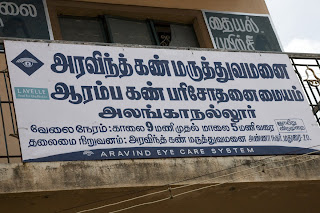
The first thing I noticed was that the start-up costs had been supported by Lavelle Fund, which is also funding our first major project in India (more on that later). Aravind doesn't like to borrow money, and start-up costs are either drawn from earnings or grants. The analysis of the placement of the Alanganallur site was reminiscent of what MacDonalds must go through when deciding to site one of their restaurants. The number of people in the town and surrounding areas, assumptions about prevalence of different eye conditions, lists of other NGOs and doctors in the area and so on. I was there the day before the one-year anniversary, and the facilities white board told the story of basically meeting the expectations set before its launch. Based on that, their business plan was to break-even after a another two years.
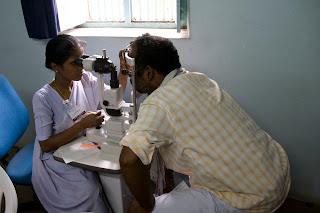
One thing I was impressed with was the telemedicine facility. Telemedicine always seemed to me to be pretty heavily hyped, and not used as much as it has been hyped. At Aravind, it doesn't seem to be hyped but gets a ton of use. While I was in the main hospital, there was a doctor on telemedicine calls with a couple of outlying facilities. The patients actually get to speak with the doctor via the link.
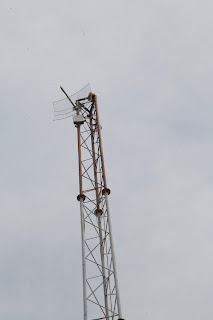
When I went to the field operation, there was the terminal with the doctor online, from the other side. The doctor was talking to another clinic, but you could see that we were next up to talk to the doctor. On the roof, I was able to check out the point-to-point Internet connection to the main hospital (30 miles away, I think).
Aravind has a plan to quadruple their activities in India over the next few years, and I am not skeptical at all about their ability to meet those objectives. People sometimes decry the infiltration of "business approaches" into the nonprofit sector, but when you visit an incredibly poor country like India and see such a systematic social enterprise campaigning successfully against needless blindness. Certainly, this is an example of where it works well. India and the region seem to specialize in these kinds of approaches. It seems required when you're trying to help millions of people!

I visited the main hospital in Madurai, where Aravind was founded by the late Dr. Venkataswamy ("Dr. V"). This was Dr V's retirement project! He came back from a visit to the United States impressed with McDonald's as a service delivery system, and decided to bring that same systematic approach to eye care. I've met with Thulsi, the executive director, in Europe at different events, but this was my first time on his (impressive) home turf.

Aravind's mission is to eliminate needless blindness, and they approach this objective with an amazing level of rigor. They are data-driven in a way that it is transparent to patients and staff alike. Every facility I saw had boards noting the daily activity. Target plans were readily accessible: I was visiting during school holidays and they were expecting more patients than typical.

I went out to one of their rural facilities, which was one year old. Aravind's data indicated that their outreach camps were only reaching 7% of the people they needed to reach. So, they decided to create rural outreach clinics with a small staff (4 in the case of Alanganallur).

The first thing I noticed was that the start-up costs had been supported by Lavelle Fund, which is also funding our first major project in India (more on that later). Aravind doesn't like to borrow money, and start-up costs are either drawn from earnings or grants. The analysis of the placement of the Alanganallur site was reminiscent of what MacDonalds must go through when deciding to site one of their restaurants. The number of people in the town and surrounding areas, assumptions about prevalence of different eye conditions, lists of other NGOs and doctors in the area and so on. I was there the day before the one-year anniversary, and the facilities white board told the story of basically meeting the expectations set before its launch. Based on that, their business plan was to break-even after a another two years.

One thing I was impressed with was the telemedicine facility. Telemedicine always seemed to me to be pretty heavily hyped, and not used as much as it has been hyped. At Aravind, it doesn't seem to be hyped but gets a ton of use. While I was in the main hospital, there was a doctor on telemedicine calls with a couple of outlying facilities. The patients actually get to speak with the doctor via the link.

When I went to the field operation, there was the terminal with the doctor online, from the other side. The doctor was talking to another clinic, but you could see that we were next up to talk to the doctor. On the roof, I was able to check out the point-to-point Internet connection to the main hospital (30 miles away, I think).
Aravind has a plan to quadruple their activities in India over the next few years, and I am not skeptical at all about their ability to meet those objectives. People sometimes decry the infiltration of "business approaches" into the nonprofit sector, but when you visit an incredibly poor country like India and see such a systematic social enterprise campaigning successfully against needless blindness. Certainly, this is an example of where it works well. India and the region seem to specialize in these kinds of approaches. It seems required when you're trying to help millions of people!

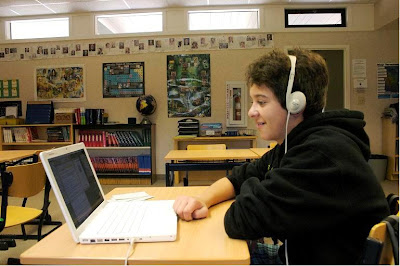
Comments